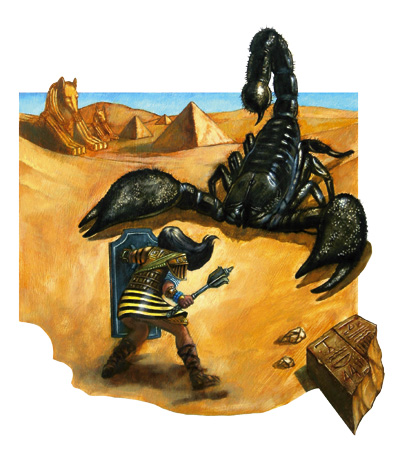| - | - | - | - | - |
| Advanced Dungeons & Dragons | - | Dragon #120 | - | Dragon magazine |
?As you crest the hill, you see a giant
scorpion ahead of you. It is facing away
from you, seeming to gaze off into the
distance.?
?I?ll put on my ring of
invisibility and
sneak past it.?
Is this possible? I thought so, until I
came across the December 1984 issue of
Scientific American. In that issue, Philip
Brownell writes about the way sand scorpions
detect their prey. Mr. Brownell?s
article was not aimed at fantasy gamers,
so he didn?t mention giant scorpions nor
any of the other concepts which interest
referees. Still, we can glean from his article
some new ideas which make giant
scorpions more interesting.
Scorpions use neither their visual or
aural senses to detect their prey. Instead,
they use the vibrations of the sand underneath
them. Small sensors on their legs
pick up and measure the strength of vibrations;
a scorpion uses the minute differences
in these vibrations picked up by
each leg to locate its prey. When the scorpion
has determined the distance and
direction of its prey, it charges toward it
with pincers extended.
Mr. Brownell gives about 30 centimeters
as the maximum distance a scorpion can
sense vibrations ? a normal-sized scorpion,
of course. A North American scorpion
averages about 5 centimeters in
length, which means the maximum detection
distance is about six times the scorpion
?s length. At a distance of about twice its
length, the scorpion is almost perfect in
determining both direction and distance to
a victim.

Mr. Brownell's experimental data points
to a method for running encounters with
giant scorpions. Up to a distance of about
three times its length, the scorpion will
always move to within a few feet of its
target before attacking. If it makes a detection
roll (1-90 on percentile dice), and if it
rolls a hit against an unarmored foe (AC
10) at the end of its charge, its pincers
have bumped against (but not grasped) its
foe, and it may attack normally.
If its prey is farther than three times its
length, the scorpion will move in the general
direction of its prey up to that distance.
(Generally speaking, the farther
away the prey is, the more tentative the
scorpion?s movement toward it will be.) In
any case, if the scorpion cannot strike at
its prey after it has moved, it pauses for a
segment, waiting for another vibration,
and reacts to it using the above guidelines.
Since the scorpion uses vibrations,
rather than sight or sound, to track its
prey, it is immune to most camouflaging
devices. Invisibility will not even confuse a
scorpion, as it attacks only if its pincers
have touched its prey by the end of the
charge toward the prey?s expected
location.
Likewise, tunneling underneath the
scorpion gives no protection. The scorpion
still realizes a character?s presence and
can dig the character out with its large
pincers. It seems obvious that a scorpion is
almost impossible to surprise by any attacker
who travels upon or under the
ground.
The scorpion's detection ability should
be immune to any attacks which directly
affect any of the senses except touch, as
that is the sense a scorpion?s vibration
sensors use. The scorpion?s attack may be
slightly affected by blinding attacks (- 1 or
-2 to hit, depending on the success or
failure, respectively, of the initial detection
roll), but sonic attacks should not affect it
at all.
If a scorpion is immune to all these
things, then what will affect it? It should
be penalized 10% on its detection roll for
each leg which is missing or crippled, as
the loss of sensory data from that leg
impairs its ability to locate by vibration.
Also, if several adjacent legs are incapacitated,
the scorpion will not be able to
accurately detect the direction of prey
which is at a 90° angle to its missing legs.
So, the proper response to the opening
situation is:
?The scorpion turns and runs directly
toward you, pincers extended and stinger
in the air, preparing to strike.?
And the player?s response is . . .
"RUNAWWWAAAYYYYY!!!"